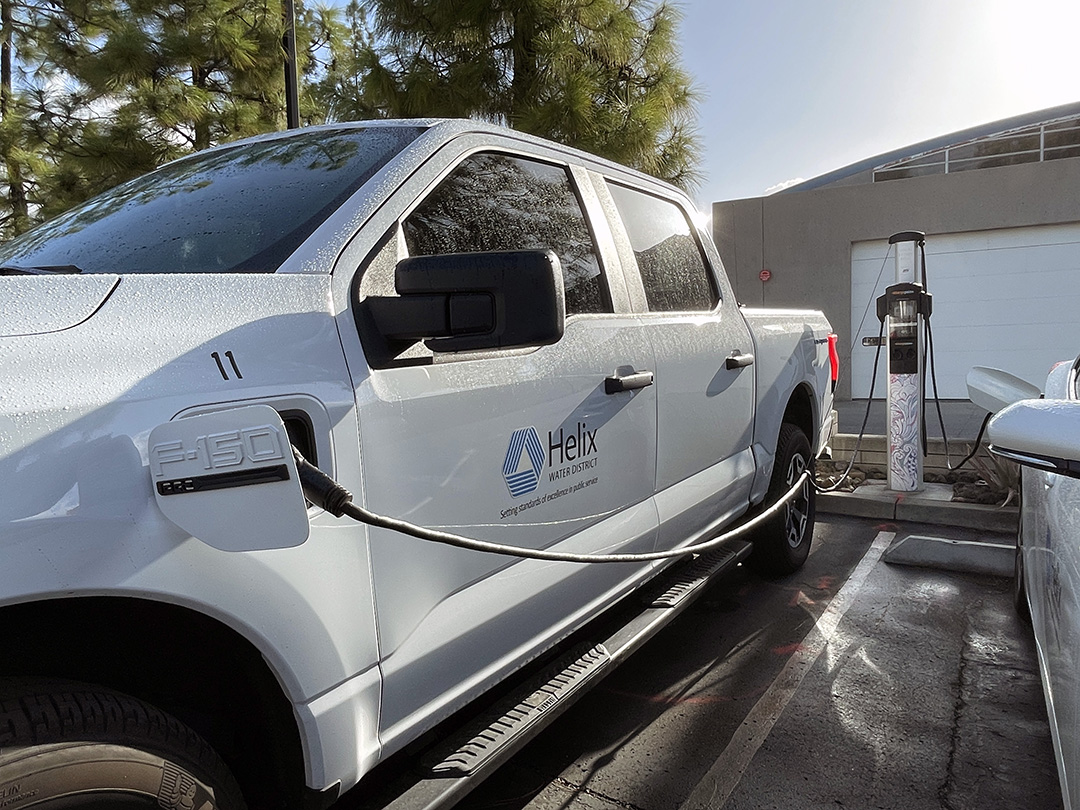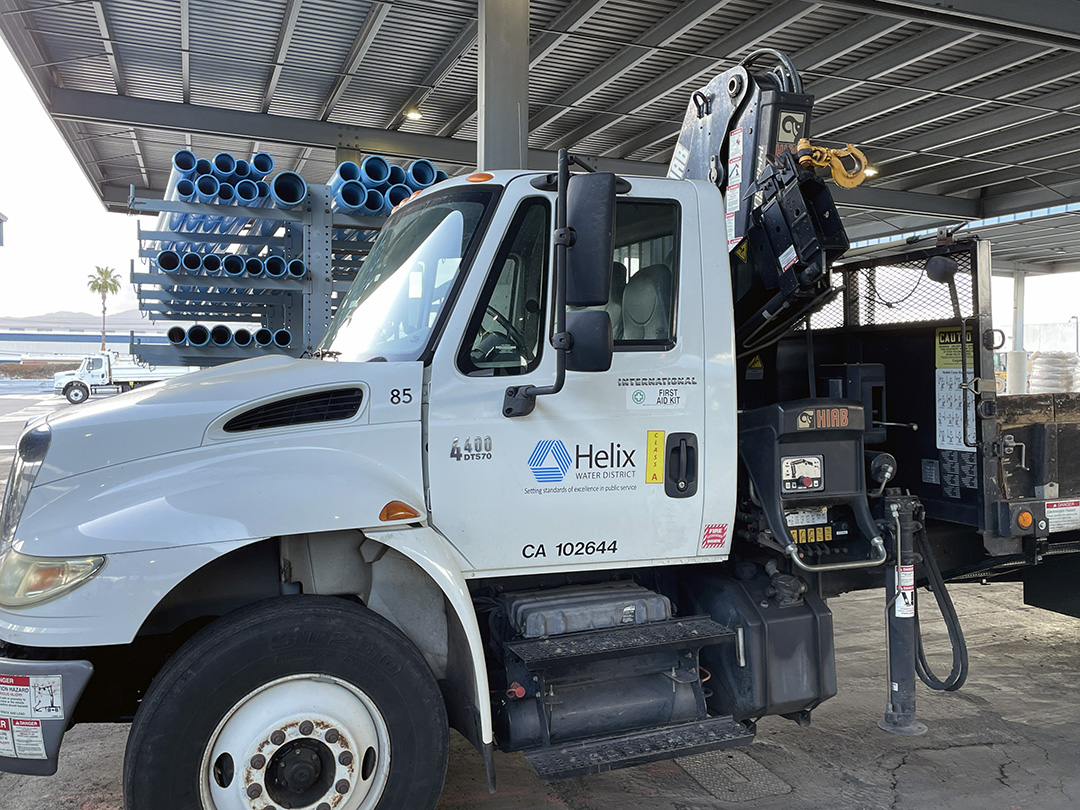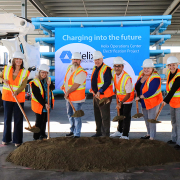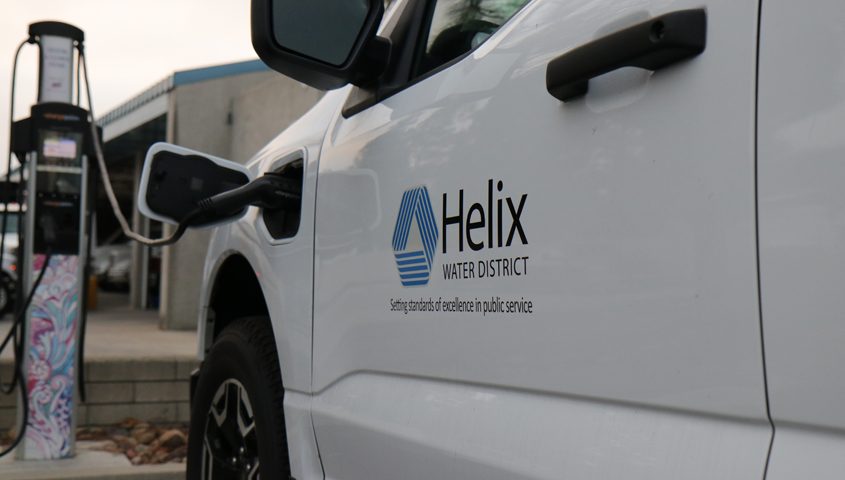Helix Water District Working Toward Zero-Emission Future
As part of its initiative to transition to a zero-emission vehicle fleet, Helix Water District leaders broke ground in late March on a retrofitting project at the district’s operations center in El Cajon.
The $11 million project, which is almost entirely grant-funded, will increase electrical capacity and charging infrastructure needed for the transition at its operations center in El Cajon. The facility will also support other East County public agencies as they work towards electrifying their own vehicle fleets.
Helix Preparing to Meet New California Requirements

Helix Water District purchased its first EV truck in 2022. Photo: Helix Water District
While all new passenger cars, trucks, and SUVs sold in California will be zero-emission by 2035, the state wants government agencies with vehicle fleets to get to zero emissions more quickly. By 2027, all new medium and heavy-duty truck purchases must be zero-emission vehicles.
The district’s fleet of vehicles is used by employees responsible for maintaining 742 miles of pipeline, valves, hydrants, and meters. While the Helix Water District first began purchasing electric vehicles in 2022 as part of its overall sustainability efforts, its current infrastructure requires upgrades to support an electric-only vehicle fleet.
“The Helix board of directors voted 5-0 to approve this project because this is the next step on the path we’ve chosen for our agency,” said board member Mark Gracyk.
“We have already reduced our energy use by 15% and our carbon footprint by 40%. This project will be a model for other agencies working to electrify their fleets and help the cities we serve meet their climate action plan goals.”
In addition to the major change in operations, the Helix Water District must maintain 24/7 readiness for emergency responses, with a vehicle fleet that requires time to recharge.
Partner Collaboration Makes Helix Project Possible

Helix Water District will work with SDG&E and the San Diego Air Pollution Control District to complete its project. Photo: Helix Water District
Retrofitting the district’s operations center to increase electrical capacity and installing the new infrastructure presented challenges. The Helix project team moved quickly to secure outside expertise and funding to get ahead of other public agencies in California competing for resources.
Through funding and technical support from the San Diego County Air Pollution Control District and San Diego Gas & Electric, Helix is ready to begin construction. The organizations guided the district through idea gathering, planning, designing, and equipment selection. The collaboration will continue through construction.
“This charging infrastructure project is particularly impactful for air quality in the area because the communities serviced by the Helix Water District have some of the highest levels of air pollution in San Diego County. SDAPCD looks forward to the full implementation of this project,” said Paula Forbis, Air Pollution Control Officer, San Diego County Air Pollution Control District.
“Our collaboration with Helix Water District and the San Diego County Air Pollution Control District exemplifies the power of partnerships in driving our progress to meeting California’s climate goals,” added Miguel Romero, Senior Vice President and Chief Commercial Officer, SDG&E.
Helix Effort Meets Climate Action Plan Goals

The district’s fleet of vehicles is used by employees responsible for maintaining 742 miles of pipeline, valves, hydrants, and meters. Photo: Helix Water District
Vehicle emissions are one of the highest sources of pollution in San Diego County. For this reason, SDAPCD considers the shift from diesel to electric vehicles one of the most impactful ways to improve air quality.
According to SDG&E, Helix Water District’s plan to transition 86 medium- and heavy-duty vehicles and install nearly six megawatts of charging infrastructure aligns with SDG&E’s mission to support public agencies and fleet operators in meeting California’s Advanced Clean Fleets (ACF) regulation and local climate action plan goals.
Helix received a $5.2 million grant from the San Diego County Air Pollution Control District, a $2.2 million grant from San Diego Gas & Electric’s Power Your Drive for Fleets Program and an additional $1.5 million through the Disadvantaged Community Electric Vehicle Charger Rebate Program. The district will fund the remaining $2 million.
“We understood early on the impact that the state’s advanced clean fleet regulation would have on the district. The cost associated with projects of this size are significant and we did not want this to impact the communities we serve, many of which are low-income communities,” said Dan McMillan, board president of the Helix Water District.
“I want to thank, on behalf of the district, San Diego Gas & Electric and the San Diego County Air Pollution Control District for their financial support. Collaboration is the only way we can move projects like this forward.”
The electrification project will take approximately one year to complete.






